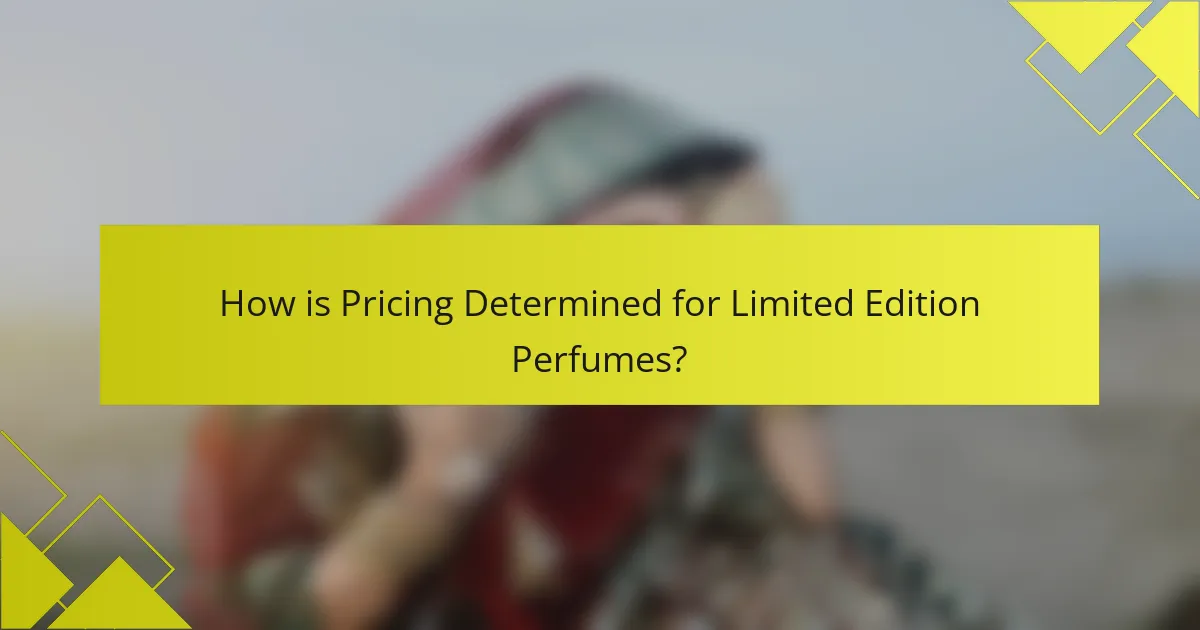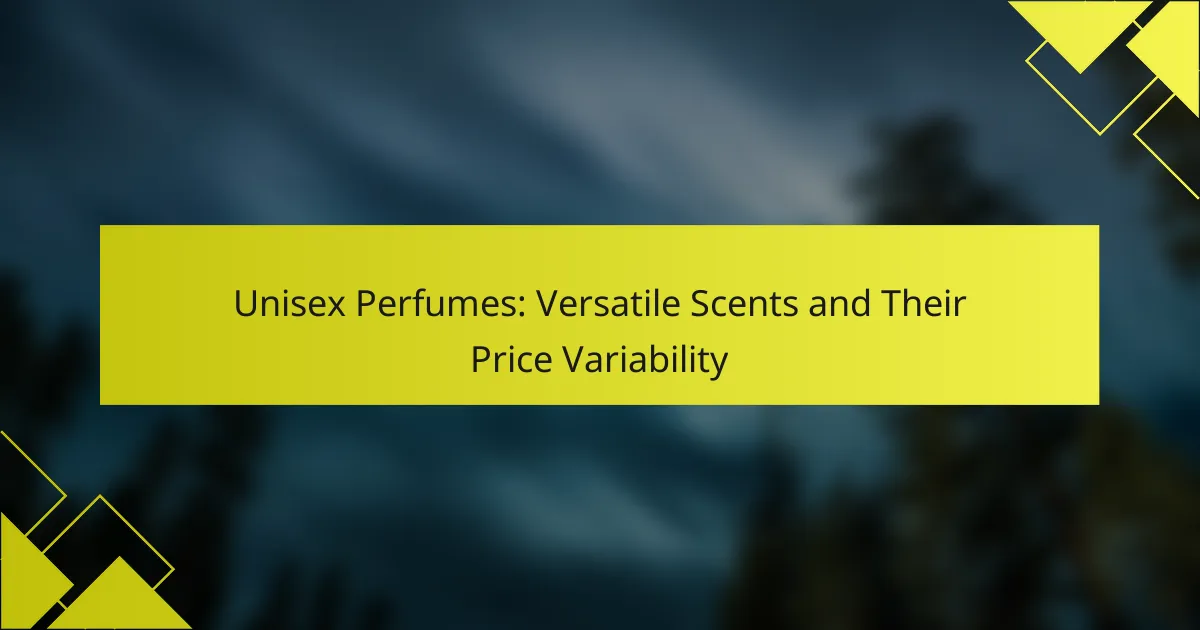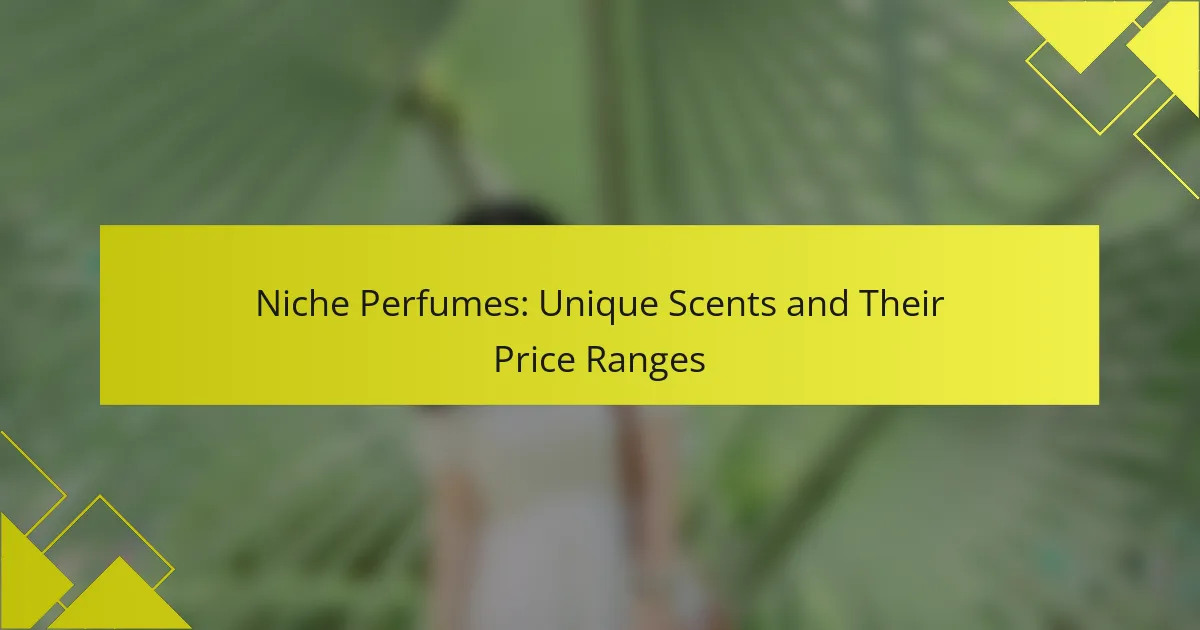
What are Limited Edition Perfumes?
Limited edition perfumes are fragrance products produced in limited quantities. These perfumes often feature unique scents that are not available in the brand’s regular lineup. They are typically released to commemorate special occasions or collaborations. The rarity of limited edition perfumes can significantly increase their desirability among collectors. Many brands announce these releases in advance, creating anticipation among consumers. The production numbers are often small, making them hard to find after the initial launch. This exclusivity can lead to higher resale values in secondary markets. For example, some limited edition perfumes have sold for several times their original retail price.
How do Limited Edition Perfumes differ from regular fragrances?
Limited edition perfumes differ from regular fragrances primarily in their exclusivity and availability. Limited edition perfumes are produced in smaller quantities, making them rare and often sought after by collectors. Regular fragrances, in contrast, are typically mass-produced and widely available.
The formulation of limited edition perfumes may also include unique notes or special ingredients not found in regular fragrances. This can enhance their appeal and justify a higher price point. The packaging of limited edition perfumes often features distinctive designs, further emphasizing their uniqueness.
For instance, brands may collaborate with artists or designers for special bottle designs. These factors contribute to the overall collectibility of limited edition perfumes, as they often become valuable over time.
What characteristics define a Limited Edition Perfume?
Limited edition perfumes are characterized by their restricted availability and unique formulations. These fragrances often feature exclusive ingredients or scent profiles not found in regular lines. Limited edition releases typically come in specially designed packaging, enhancing their collectible appeal. They are produced in small quantities, which increases their rarity and desirability among consumers. Additionally, these perfumes may be linked to specific events, anniversaries, or collaborations, adding to their significance. The exclusivity often leads to higher pricing compared to standard offerings. Collectors and enthusiasts value limited edition perfumes for their uniqueness and potential for appreciation in value over time.
Why are Limited Edition Perfumes considered special?
Limited Edition Perfumes are considered special due to their exclusivity and unique formulations. These perfumes are often produced in limited quantities, making them rare. The scarcity creates a sense of urgency among collectors and enthusiasts. Many brands collaborate with renowned artists or designers for these editions, enhancing their appeal. Additionally, they often feature distinct packaging that sets them apart from standard offerings. The combination of rarity, unique artistry, and specialized marketing contributes to their elevated status. Collectors often seek these perfumes for their potential value appreciation over time. Limited Edition Perfumes thus embody a blend of artistry, rarity, and investment potential.
What factors contribute to the rarity of Limited Edition Perfumes?
Limited edition perfumes are rare due to several key factors. Firstly, production quantities are intentionally limited by brands. This creates exclusivity and increases demand among collectors. Secondly, unique formulations often feature rare ingredients. These ingredients can be difficult to source, adding to the perfume’s allure. Thirdly, specific packaging designs are often created for these editions. Distinctive bottles or artwork contribute to their collectible nature. Fourthly, marketing strategies emphasize scarcity. Brands promote limited releases to heighten interest and urgency among consumers. Finally, the historical significance of some editions can enhance their rarity. Perfumes linked to special events or collaborations become sought-after items. These factors collectively contribute to the rarity of limited edition perfumes.
How does production quantity impact rarity?
Production quantity directly influences rarity in limited edition perfumes. Lower production quantities create higher rarity. When fewer units are produced, the availability decreases. This scarcity often drives demand among collectors. For instance, a perfume limited to 100 bottles is more sought after than one with 1,000 bottles. The unique nature of low production increases perceived value. Consequently, this can lead to higher resale prices in the market. Rarity is a key factor in the desirability of perfumes among enthusiasts and collectors.
What role does exclusivity play in the perception of rarity?
Exclusivity significantly enhances the perception of rarity. When something is exclusive, it is available to a limited audience. This limitation creates a sense of scarcity. Scarcity often elevates desirability. In the context of limited edition perfumes, only a select number of bottles are produced. For example, a perfume released in 500 bottles is perceived as more special than one available in 50,000. The fewer the items, the greater the allure. This principle is supported by consumer behavior studies indicating that exclusivity drives demand and increases perceived value. Therefore, exclusivity is a crucial factor in how rarity is perceived in the luxury market.
Why are Limited Edition Perfumes highly collectible?
Limited edition perfumes are highly collectible due to their rarity and exclusivity. These fragrances are produced in limited quantities, making them scarce in the market. Collectors often seek unique scents that are not widely available. The allure of owning something that few others possess drives demand. Additionally, many limited editions feature special packaging or collaborations with artists. These unique attributes enhance their appeal among enthusiasts. Historical context shows that limited edition items often appreciate in value over time. For example, certain limited releases can sell for several times their original retail price. This combination of rarity, uniqueness, and potential investment value makes limited edition perfumes particularly sought after.
What motivates collectors to pursue Limited Edition Perfumes?
Collectors pursue Limited Edition Perfumes primarily due to their rarity and exclusivity. Limited editions often feature unique scents not available in regular lines. This uniqueness enhances their appeal among enthusiasts. The packaging of these perfumes is often artistically designed, adding aesthetic value. Additionally, collectors view these items as investments. The value of limited edition perfumes can appreciate over time. According to a study by the Fragrance Foundation, limited editions often retain or increase their market value. This potential for financial gain motivates many collectors to seek them out. The community aspect also plays a role, as collectors often share their finds and experiences.
How does the history of a fragrance influence its collectibility?
The history of a fragrance significantly influences its collectibility. Collectors often seek fragrances with a rich backstory or unique origin. For example, fragrances associated with specific historical events or cultural milestones tend to attract higher interest. Limited edition releases that commemorate anniversaries or collaborations also enhance desirability. The scarcity of a fragrance can increase its value over time. Historical context, such as the reputation of the perfumer or the brand’s legacy, adds to the allure. Additionally, fragrances that have garnered awards or critical acclaim are often more collectible. Overall, a fragrance’s history creates a narrative that enhances its appeal to collectors.

How is Pricing Determined for Limited Edition Perfumes?
Pricing for limited edition perfumes is determined by several key factors. Rarity significantly influences price; the fewer bottles produced, the higher the price tends to be. Brand reputation also plays a crucial role; established brands can command higher prices. Unique scent compositions and high-quality ingredients contribute to pricing as well. Packaging and design are important; luxurious packaging can elevate perceived value. Market demand affects pricing; strong consumer interest can drive prices up. Historical sales data shows that limited editions often appreciate in value over time. Collectibility is another factor; perfumes that are sought after by collectors can see inflated prices in secondary markets.
What are the main factors that influence the pricing of Limited Edition Perfumes?
The main factors that influence the pricing of Limited Edition Perfumes include rarity, brand reputation, and production costs. Rarity drives demand, as consumers value exclusive products. Limited availability can significantly increase a perfume’s price. Brand reputation also plays a crucial role; established brands can command higher prices. Production costs, including ingredients and packaging, impact the final price. Unique attributes, such as bespoke formulations or collaborations with renowned artists, can further elevate pricing. Market trends and consumer preferences additionally affect pricing strategies. Collectibility is enhanced by these factors, making limited editions sought after by enthusiasts.
How does brand reputation affect pricing?
Brand reputation significantly influences pricing strategies. A strong brand reputation often allows companies to command higher prices. Consumers perceive products from reputable brands as higher quality. This perception leads to a willingness to pay a premium. For example, luxury brands like Chanel and Dior set higher prices due to their established reputations. According to a study by the Journal of Marketing Research, brands with positive reputations can see price premiums of up to 20%. Conversely, brands with poor reputations may struggle to maintain competitive pricing. This dynamic is especially evident in markets for limited edition perfumes, where brand prestige enhances perceived value.
What is the impact of packaging and presentation on price?
Packaging and presentation significantly influence the price of limited edition perfumes. High-quality packaging enhances perceived value. Unique designs attract collectors and justify higher prices. Studies show that consumers are willing to pay more for aesthetically pleasing packaging. For example, luxury brands often use elaborate boxes and bottles to create exclusivity. This strategy can increase a perfume’s price by 20% to 50%. Additionally, presentation in marketing materials can elevate brand prestige. Overall, effective packaging and presentation create a strong association with luxury and rarity, leading to higher pricing.
How can market demand affect the pricing of Limited Edition Perfumes?
Market demand significantly influences the pricing of limited edition perfumes. When demand is high, brands can set higher prices due to perceived value. Limited availability creates a sense of exclusivity, driving consumer interest. For example, a limited edition perfume may sell for double its original price if it becomes a collector’s item. Conversely, if demand is low, brands may reduce prices to encourage sales. Historical data shows that limited edition releases from luxury brands often see price increases shortly after launch. This correlation highlights how market demand directly impacts pricing strategies in the perfume industry.
What trends currently influence the demand for Limited Edition Perfumes?
The demand for Limited Edition Perfumes is influenced by several key trends. First, the growing consumer interest in unique and exclusive products drives demand. Consumers increasingly seek individuality in their fragrance choices. Second, social media marketing amplifies brand visibility and desirability. Influencers often showcase limited editions, creating buzz and urgency. Third, sustainability trends affect consumer preferences. Brands that use eco-friendly ingredients and packaging attract environmentally conscious buyers. Additionally, collaborations with celebrities or artists enhance the appeal of limited editions. Such partnerships often result in unique scents that resonate with fans. Lastly, the rise of e-commerce facilitates easier access to these limited offerings. Online platforms allow consumers to purchase exclusive perfumes from the comfort of their homes. These trends collectively shape the current market landscape for Limited Edition Perfumes.
How does the timing of a release impact its market price?
The timing of a release significantly impacts the market price of limited edition perfumes. Releases timed for holidays or special events often see higher demand. Increased demand typically drives up the price. Conversely, releasing a product during off-peak times may lead to lower prices. Historical data shows that perfumes launched during festive seasons often sell out quickly, increasing their secondary market value. For instance, a limited edition fragrance released during Christmas can see a price increase of 30% within weeks of launch. Thus, strategic timing can enhance perceived value and market price.
What are some examples of notable Limited Edition Perfumes and their prices?
Creed’s “Aventus for Her” is a notable limited edition perfume priced around $350. Chanel’s “Les Exclusifs de Chanel” collection features “Coromandel,” with a price of approximately $200. Tom Ford’s “Private Blend” series includes “Tobacco Vanille,” available for about $250. Dior’s “La Collection Privée” offers “Fève Délicieuse,” priced around $300. Each of these perfumes is recognized for its unique scent profile and collectible nature.
Which Limited Edition Perfumes have achieved the highest resale values?
Limited edition perfumes that have achieved the highest resale values include Clive Christian No. 1 and Chanel Grand Extrait. Clive Christian No. 1 has sold for over $2,000 per ounce, making it one of the most expensive perfumes globally. Chanel Grand Extrait is highly sought after, with resale prices reaching up to $4,000 for a 7.5 oz bottle. Other notable mentions are the limited edition versions of Tom Ford’s Black Orchid and the Maison Francis Kurkdjian Baccarat Rouge 540. These perfumes have seen significant appreciation in resale markets due to their rarity and brand prestige.
What are some recent releases that have gained attention in the market?
Recent releases in the limited edition perfume market include brands like Chanel and Dior. Chanel’s “Les Exclusifs de Chanel” line recently launched a new fragrance, “Coromandel.” This release has attracted attention for its unique blend of patchouli and frankincense. Additionally, Dior’s “La Collection Privée” introduced “Cuir Cannage,” which features leather notes combined with floral undertones. Both perfumes have received positive reviews from fragrance enthusiasts and collectors. These releases highlight the trend towards exclusivity and craftsmanship in the perfume industry.

What are the Best Practices for Collecting Limited Edition Perfumes?
To collect limited edition perfumes effectively, prioritize authenticity and research. Verify the legitimacy of the perfume through reputable sources. Understand the brand’s history and the specific release details of each limited edition. Join collector communities for insights and tips. Store perfumes in a cool, dark place to preserve their quality. Keep original packaging to maintain value. Track market trends to make informed purchasing decisions. Attend fragrance fairs or auctions to discover rare finds.
How can collectors identify genuine Limited Edition Perfumes?
Collectors can identify genuine Limited Edition Perfumes by examining specific characteristics. Authentic limited editions typically feature unique packaging and labeling. The presence of serial numbers or batch codes is also a strong indicator of authenticity. Collectors should verify these codes with the brand’s official database. Additionally, limited editions often come with a certificate of authenticity. This certificate should include details about the edition and production run. Researching the brand’s history and reputation can provide further insight. Lastly, purchasing from reputable retailers or directly from the brand reduces the risk of counterfeits.
What signs indicate authenticity in Limited Edition Perfumes?
Authenticity in limited edition perfumes can be indicated by several signs. First, check for a unique batch number or serial code on the packaging. Authentic brands often include this to track production. Second, examine the quality of the packaging. Genuine products typically have high-quality materials and printing. Third, look for a certificate of authenticity or documentation from the brand. Many limited editions come with this proof. Fourth, assess the scent profile. Authentic perfumes have a consistent and well-balanced fragrance. Lastly, purchase from reputable retailers or directly from the brand. This reduces the risk of counterfeit products.
How can packaging help verify a perfume’s limited status?
Packaging can help verify a perfume’s limited status through distinctive design features. Limited edition perfumes often utilize unique packaging elements like special colors, materials, or shapes. These design choices set them apart from regular editions. Additionally, packaging may include numbering, such as “1 of 500,” indicating exclusivity. This numbering creates a sense of rarity among collectors. Furthermore, brands often incorporate holograms or seals to authenticate limited editions. These security features prevent counterfeiting and enhance trust. Overall, the packaging serves as a visual and physical representation of a perfume’s limited availability.
What strategies can collectors use to build a valuable collection?
Collectors can build a valuable collection by focusing on rarity, brand reputation, and market trends. Investing in limited edition perfumes is essential, as their scarcity often increases value over time. Researching the history and production numbers of specific fragrances helps identify which items are truly rare. Networking with other collectors can provide insights into valuable pieces and upcoming releases. Attending fragrance exhibitions and auctions exposes collectors to unique opportunities. Proper storage conditions preserve the integrity and value of the perfumes. Keeping detailed records of purchases and provenance adds to the collection’s credibility. Lastly, staying informed about industry trends ensures collectors make educated decisions.
How important is networking within the perfume community?
Networking within the perfume community is crucial for success. It facilitates the exchange of knowledge and trends. Connections can lead to exclusive opportunities in limited edition releases. Relationships with industry insiders enhance access to rare fragrances. Networking also fosters collaboration among perfumers and collectors. Engaging in community events builds visibility and reputation. Statistics show that over 70% of professionals find jobs through networking. Thus, strong connections can significantly impact career growth in the perfume industry.
What role does research play in successful collecting?
Research plays a crucial role in successful collecting of limited edition perfumes. It enables collectors to understand market trends and pricing dynamics. Detailed research helps identify authentic products versus counterfeits. Collectors can assess the rarity and desirability of specific editions through historical data. Knowledge of a perfume’s brand story enhances its collectibility. Research also uncovers the best places to acquire sought-after items. Additionally, it informs collectors about potential future value appreciation. Accurate information is essential for making informed purchasing decisions.
What tips can help new collectors get started with Limited Edition Perfumes?
Start by researching brands that release limited edition perfumes. Familiarize yourself with their history and reputation. Join online forums and communities dedicated to perfume collecting. This will provide insights and recommendations. Attend fragrance events and exhibitions to discover new releases. Keep track of launch dates for limited editions from your favorite brands. Set a budget to manage your spending effectively. Finally, prioritize purchasing from reputable retailers to ensure authenticity. These steps will help establish a solid foundation for your collection.
Limited edition perfumes are fragrance products produced in small quantities, featuring unique scents and packaging that set them apart from regular fragrances. The article explores the characteristics that define these perfumes, including their rarity, exclusivity, and the factors influencing their desirability among collectors. It also examines how pricing is determined, highlighting the impact of production quantity, brand reputation, and market demand. Additionally, the article discusses the best practices for collecting limited edition perfumes, including tips for identifying authenticity and strategies for building a valuable collection.



